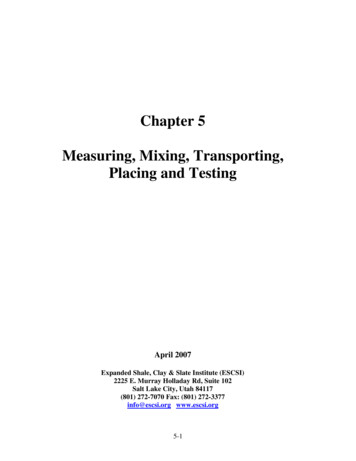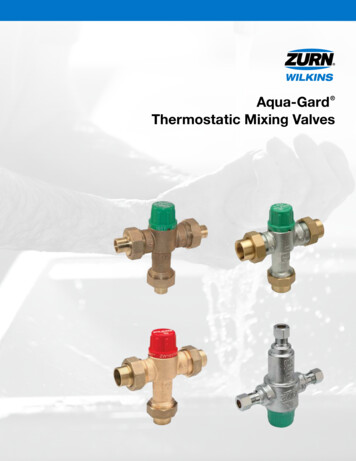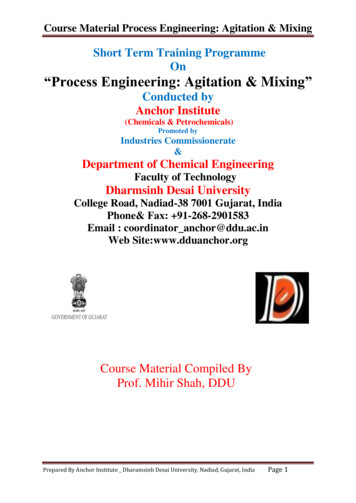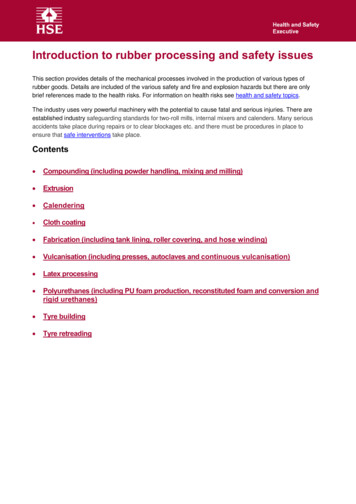
Transcription
Chapter 5Measuring, Mixing, Transporting,Placing and TestingApril 2007Expanded Shale, Clay & Slate Institute (ESCSI)2225 E. Murray Holladay Rd, Suite 102Salt Lake City, Utah 84117(801) 272-7070 Fax: (801) 272-3377info@escsi.org www.escsi.org5-1
CHAPTER 55.05.15.25.3Measuring, Mixing and TransportingPlacingPumping Lightweight ConcreteConsolidationFinishing FloorsCuringLaboratory and Field ControlLaboratory Testing ProgramsAppendix 5AEvaluation of Non-Destructive Strength Testing of Lightweight Concrete5-2
CHAPTER 5 MEASURING, MIXING, TRANSPORTING, PLACINGAND TESTING5.0Measuring, Mixing and TransportingThe fundamental principles of ASTM C 94 and ACI 304 apply to lightweightconcrete as they do to normalweight concrete. Aggregates need to be handledaccording to the procedures that have been established by the aggregate supplieror the ready-mixed concrete producer. The absorptive nature of the lightweightaggregate requires prewetting to as uniform moisture content as possible beforeadding the other ingredients of the concrete (ACI 213, 302, 304).Section 5.1.2 of the materials section of ASTM C 94 requires normalweightaggregates to conform to specification C 33 and lightweight aggregates toconform to C 330. Therefore C 94 permits the use of any combination of theseaggregates providing they meet their appropriate specification.Lightweight concrete can be transported by the same means used fornormalweight concrete. This includes ready-mix trucks, pumping, or conveyorbelts. The method of transportation used should effectively deliver thelightweight concrete to the point of placement without significantly altering itsdesired properties with regard to water-cementitious materials ratio, slump, aircontent, density, and homogeneity. The method of transportation needs to bedetermined at preconstruction meetings with consideration given to mixtureingredients and proportions, type and accessibility of placement, required deliverycapacity, location of the batch plant, and weather conditions. These variousconditions should be carefully reviewed in selecting the type of transportationbest suited for economically obtaining quality concrete in place. ACI 304Rprovides descriptions of the various concrete transportation systems.5.1PlacingThere is little difference in the techniques required for placing lightweightconcrete from those used in properly placing normalweight concrete. ACI 304.5Rdiscusses in detail the proper and improper methods of placing concrete. Themost important consideration in handling and placing concrete is to avoidsegregation of the coarse aggregate from the mortar matrix. The basic principlesrequired for a good lightweight concrete placement are:A workable mixture that meets both quality and placement requirements;Equipment capable of expeditiously handling and placing the concrete;Proper consolidation; andGood workmanship.5-3
Because of its lower density well-proportioned lightweight concrete mixture cangenerally be placed, screeded, and floated with less effort than that required fornormalweight concrete. Over-vibration or overworking of lightweight concreteshould be avoided. Delamination issues have been reported on air-entrainednormalweight and lightweight concrete floors when riding trowels with float panshave been used prematurely. Over-manipulation can bring excessive mortar tothe surface. Upward movement of coarse lightweight aggregate may also occur inmixtures where the slump exceeds the recommendations provided in this chapter.Pumping Lightweight Concrete (also see ESCSI Information Sheet 4770.1)General considerations – Unless the lightweight aggregates are satisfactorilyprewetted, they may absorb mixing water and subsequently cause difficulty inpumping the concrete. For this reason, it is important to adequately condition theaggregate by fully prewetting before batching the concrete. The conditioning ofthe lightweight aggregate can be accomplished by any of the following:Atmospheric – Using a soaker hose or sprinkler system. The length oftime required to adequately prewet a lightweight aggregate is dependenton the absorption characteristics of the aggregate. The lightweightaggregate supplier may be able to supply useful information. Uniformprewetting can be accomplished by several methods, including sprinkling,using a soaker hose, and by applying water to aggregate piles at either orboth the aggregate plant or batch plants.Thermal – By immersion of partially cooled aggregate in water. It shouldbe carefully controlled and is feasible only at the aggregate plant.Vacuum – By introducing dry aggregate into a vessel from which the aircan be evacuated. The vessel is then filled with water and returned toatmospheric pressure. This is normally performed only at the aggregateplant.Prewetting minimizes the mixing water being absorbed by the aggregate,therefore minimizing the slump loss during pumping. This additional moisturealso increases the density of the lightweight aggregate. This increased densitydue to prewetting will contribute to cement hydration with the remaindereventually being lost to the atmosphere (see section 6.2).Proportioning pump mixtures – When considering pumping lightweight concrete,some adjustments may be necessary to achieve the desired characteristics. Thearchitect/engineer and contractor should be familiar with any mixture adjustmentsrequired before the decision is made as to the method of placement. The readymixed concrete producer and aggregate supplier should be consulted so that thebest possible pump mixture can be produced.5-4
When the project requirements call for pumping, the following “Team approach”rules apply. These are based on the use of lightweight coarse aggregate andnormalweight fine aggregate.“The Team Approach”Design Engineer1.2.3.4.5.6.7.8.9.Mixes that are regularly used in a market area will be the mosteconomical. Consult the lightweight aggregate suppliers fordetailed mixture design information and material capabilities (i.e.,unit weight, strength, etc.)Specify 4 to 7 percent air entrainment for pumpability, workability,finishability, and durability.Specify the maximum size aggregate rather than specifyingindividual sizes.Allow higher slump into the pump to accommodate possible slumploss (slump control at discharge of pump).Have the testing lab run design curves based on the maximumspecified slump and air per ACI 301.Specify a pre-pump meeting with the following present: engineer,architect, contractor, ready-mix supplier, lightweight aggregatesupplier, testing agency, admixture supplier, and pumpingcontractor.On large jobs, these same people should be present at the firstconcrete pump placement.Specify exactly where concrete should be tested, preferably at theend of the discharge line as per ACI 304.2R.Realize that absorbed water does not affect the water/cement ratio,as defined in ASTM C 125.General Contractor1.2.3.4.5.6.7.8.Keep everyone communicating; this is a team effort!Use an experienced pumping contractor.Make arrangements so that two ready-mix trucks can unloadsimultaneously.Designate a laborer to help the testing lab inspector.Provide a washout area for ready-mix trucks.Make use of the ready-mix truck radio when placement delaysoccur.Specify to the ready-mix supplier the number of yards needed perhour, not how many truckloads.Make an agreement with the ready-mix supplier as to how thequantity of concrete delivered will be determined.5-5
9.It is necessary to properly lubricate the pump line before placingconcrete.Pumping Contractor1.2.3.4.5.6.7.Know the concrete unit weight being pumped.Order concrete to coincide with actual pumping time, not when thepump arrives at the job site.Maintain continuous placement.Operator should know the maximum slump allowed.Use 5" minimum clean steel lines; minimize rubber at the end ofline; avoid reducers if possible.Keep the same pump and operator throughout the duration of thejob.Use a pump whose piston size is as close as possible to the linesize to maintain the best performance and least slump loss.Ready-Mix Producers1. The lightweight aggregate must be prewetted prior to batching usingprocedures recommended by the lightweight aggregate supplier.2. Check with the lightweight aggregate supplier for the recommendedpump mix design and field correction procedures.3. The aggregate moisture content or unit weight should be checkedfrequently. This is necessary for concrete yield control.4. Make drivers aware of what admixtures are being used for slumpcontrol.5. Maintain a minimum 3" slump before the addition of “superplasticizer”.Testing Labs1. The field inspector shall be ACI Field Technician Grade 1 (orequivalent) per ASTM C 94.2. Make sure the inspector has the proper tools including a roll-a-meterfor volumetric air tests and a proper strike-off plate for unit weightdetermination.3. On large jobs use the same inspector for all concrete placements.4. The inspector should know fresh unit weight limitations (min andmax).5. Place test cylinders immediately upon casting in a curing boxprotected from the ambient temperature and vibration per ASTM C 31.6. Sample for density, slump and air early.5-6
7. Communicate test results promptly to designated(superintendent, engineer, Q/C representative, architect, etc.)partiesConsolidationDuring vibration of lightweight concrete, the entrapped air bubbles are brought tothe surface through buoyancy and are dissipated in a similar fashion tonormalweight concrete. However, the lower density of the mixture results insomewhat less buoyancy for the air bubble. Vibration should continue untilentrapped air is removed and stopped before mixture segregation.Segregation of the concrete mixture ingredients during vibration is caused bydifferences in material densities. In normalweight concrete, the coarse aggregateis heavier than the mortar and therefore tends to sink during vibration. Inlightweight, the reverse is true, although the tendency for the coarse aggregate tofloat is less when the mortar contains lightweight fine aggregate. Dry mixtureswill not segregate as rapidly under vibratory action as wet mixtures.A thorough discussion of consolidation is given in ACI 309R. The equipment andprocedures recommended for consolidating normalweight concrete are alsosuitable for lightweight concrete, with some additional considerations asdescribed in the following paragraphs.As with normalweight concrete, lightweight concrete should be placed as closelyto its final position as practicable to avoid segregation. Vibrators should not beused to move the concrete laterally. Shovels are frequently helpful in depositingor moving the concrete.Finishing FloorsAir-entrained structural lightweight concrete has a long history of successful useon suspended floor slabs. This was achieved with properly proportioned qualitymaterials, skilled supervision, and good workmanship. The quality of thefinishing will be in direct proportion to the efforts expended to ensure that properprinciples are observed throughout the finishing process. Finishing techniques forlightweight concrete floors are described in ACI 302.1R.Building codes mandate the requirements for fire rated floor assemblies and areexplicit with regard to the use of structural lightweight concrete. The concreteused in Fire Rated Underwriter Laboratory floor assemblies, and tested inaccordance with ASTM E 119, are assembly specific as regards to density (unitweight) and air content.5-7
By definition, lightweight concrete is lighter than normalweight concrete. This ismade possible by replacing heavy, ordinary aggregate with expanded shale, clayor slate lightweight aggregate, and by maintaining air content at approximately6%. Air entrainment in concrete improves durability and workability, reducesbleeding, and is recommended for lightweight concrete by both ACI 211.2 andACI 302. For workability and weight reduction, ESCSI recommends 4 to 6percent air entrainment.The typical lightweight suspended floor slab is used with floor coverings for foottraffic in office, commercial, multi-unit residential and institutional buildings.ACI 302 calls this type of floor a Class 2 Floor with a flat and level slab suitablefor applied coverings, and having a “light” steel-troweled finish. The floorflatness/levelness tolerances for this floor are FF25/FL20. On some occasions,flatness/levelness tolerances are higher to meet specific design requirements. The“light” steel-troweled finish is not the same as “normal” or “hard” steel-troweledfinish recommended by ACI 302 for commercial or industrial floors subject tovehicular traffic.The increasing call for faster construction and flatter tolerances has increased theuse and development of ride-on power trowels with float pans. This equipment iscapable of providing flat floors with a minimal amount of labor, and has beenused extensively on non-air entrained slab-on-grade concrete. It is now beingused successfully on many elevated floors which are usually constructed withlightweight concrete. The user of this equipment needs to be aware thatlightweight concrete is normally air entrained at about 5-6%, and has a differenttiming sequence during finishing.Ride-on power trowels with pan floats impart more energy to the concrete surfaceat an earlier age than walk-behind power trowels. Power trowels with pan floatsexert much lower surface pressures, thereby allowing the contractor to commencefinishing sooner with this equipment. This can contribute to delamination issues.Concrete Construction, March 1998, pp. 277-283, reported surface pressures of0.36 to 0.98 psi for walk-behinds and ride-on power trowels equipped withblades, 0.16 to 0.42 psi for pan floats, and 3.3 to 6.0 psi surface pressure for aperson walking on the concrete. ACI 302 recommends that machine floating bestarted when the concrete will support a finisher on foot without more than a 1/8to a 1/4 inch indentation. As a general rule, ACI 302 also recommends that whenflatness tolerances are not high, power floating should be started as late aspossible. This is indicated when a foot print is barely perceptible.Problems may develop when the floor is power floated prematurely or overworked. This is not a new development. For many decades, delamination hasbeen known to apply to inappropriately timed troweling.5-8
Manny Mattos of D&M Concrete Floor Company, Fall River, MA, has reportedthat success of time-tested rules of thumb for finishing concrete and knowingwhen to start power floating: (1) When the top surface allows a footprintindentation no deeper than 1/8". or in some cases 1/4 "; (2) When no bleed watersheen is visible on the surface. “We finished a lot of lightweight air entrainedconcrete floors without blistering or delamination problems. We always start ourpower floating operation on a lightweight floor using a 36" walk-behind machinewith a float pan. This ensures we are not on the floor too soon, because the heel(footprint) test is fool-proof. After the first power float, we then use a ride-onpower trowel with float pans”.Awareness of surrounding weather conditions must also be taken intoconsideration. Sun, wind and broad changes in temperature and humidity duringthe placing and finishing operation will play a big part in crusting, blistering anddelamination issues. These conditions need to be part of the discussion at a preslab construction meeting.Slump - Slump is an important factor in achieving a good floor surface withlightweight concrete and generally should be limited to a maximum of 5 in. (125mm). A lower slump of about 3 in. (75 mm) imparts sufficient workability andalso maintains cohesiveness and body, thereby preventing the lower-densitylightweight coarse particles from working to the surface. This is the reverse ofnormalweight concrete where segregation results in an excess of mortar at thesurface. In addition to surface segregation, a slump in excess of 5 in. (125 mm)may cause unnecessary finishing delays.Good practice - A satisfactory finish on lightweight concrete floors can beobtained as follows:a. Prevent segregation by:1. Using a well-proportioned and cohesive mixture;2. Requiring a slump as low as possible;3. Avoiding over-vibration;c. Time the placement operations properly;d. Use magnesium, aluminum, or other satisfactory finishing tools;e. Perform all finishing operations after free surface bleeding water hasdisappeared; andf. Cure the concrete properly.CuringUpon completion of the finishing operation, curing of the concrete should beginas soon as possible. Ultimate performance of the concrete will be influenced bythe extent of curing provided. ACI 302.1R and ACI 308.1 contain information onproper curing of concrete floor slabs.5-9
Unlike traditional curing where moisture is applied to the surface of the concrete,internal curing occurs by the release of water absorbed within the pores oflightweight aggregate. Absorbed water does not enter the w/cm ratio that isestablished at the time of set. As the pore system of the hydrating cementbecomes increasingly smaller, water contained within the relatively larger poresof the lightweight aggregate particle is wicked into the matrix, thus providing anextended period of curing. The benefits of internal curing have been known forseveral decades where ordinary concrete incorporating the lightweight aggregatewith a high degree of absorbed water has performed extremely well in bridges,parking structures, and other exposed structures. Internal curing is beneficial forhigh-performance concrete mixtures containing supplementary cementitiousmaterials, especially where the w/cm is less than 0.45. These low w/cm mixturesare relatively impervious and vulnerable to self-desiccation because externalsurface curing moisture is unable to penetrate.5.2Laboratory and Field ControlChanges in absorbed moisture or relative density of lightweight aggregates, whichresult from variations in initial moisture content or grading, and variations inentrained-air content suggest that frequent checks of the fresh concrete should bemade at the job site to ensure consistent quality (ACI 211.1). Sampling should bein accordance with ASTM C 172. Tests normally required are: density of thefresh concrete (ASTM C 138); standard slump test (ASTM C 143); air content(ASTM C 173); and Standard Practice for Making and Curing Concrete TestSpecimens in the Field (ASTM C 31).At the job start, the fresh properties, density, air content, and slump should bedetermined promptly to verify that the concrete conforms to the laboratorymixture. Small adjustments may then be made necessary. In general, whenvariations in fresh density exceed 3 lb/ft³ (48 kg/m³), an adjustment in batchweights may be required to meet specifications. The air content of lightweightconcrete should not vary more than 1-1/2 percentage points from the specifiedvalue to avoid adverse effects on concrete density, compressive strength,workability, and durability.5.3Laboratory Testing ProgramsSystematic laboratory investigations into the physical and engineering propertiesof high strength lightweight concrete are too numerous to be elaborated here.Most early programs extending strength/density relationships were conducted bylightweight aggregate manufacturers and innovative precast concrete producersstriving for high early-release strengths, longer span flexural members, or tallerone-piece precast columns (Holm 1980a). These in-house programs developedfunctional data directly focused on specific members supplied to projects. Ingeneral, project lead-times were short, the practical considerations of shipping anderection were immediate, and mixtures were targeted toward satisfying specific5-10
job requirements. This type of research brought about immediate incrementalprogress but, in general, was not sufficiently comprehensive.Unfortunately, some investigations did not take advantage of the advancedadmixture formulations or pozzolans and slag (i.e., HRWRA, silica fume, fly ash,ground granulated blast-furnace slag) that significantly improve matrix quality,and as such provide data of no commercial value. These investigations, as well asothers incorporating unrealistic mixtures, inappropriate lightweight aggregate, orimpractical density combinations, are not reported.Special requirements of offshore concrete structures have now brought about anexplosion of practical research into the physical and engineering properties ofhigh strength lightweight concrete. Several large, initially confidential jointindustry projects have become publicly available as the sponsors release dataaccording to an agreed-upon timetable. These monumental studies, one of whichwas summarized by Hoff (1992), in addition to providing comprehensive physicalproperty data on high strength lightweight concrete and high strength specifieddensity concrete developed innovative testing methods such as, revolving disctumbler and sliding contact ice-abrasion wear tests, freeze/thaw resistance tospectral cycles, and freeze bond testing techniques, which measured propertiesunique to offshore applications in the Arctic.Major North American laboratory studies into properties of high strengthlightweight concrete include those conducted at or sponsored by Expanded Shale,Clay, and Slate Institute (1960); Malhotra (1981, 1987); Seabrook and Wilson(1988); Ramakrishnan, Bremner, and Malhotra (1991); Berner (1992); and Luther(1992). Because of their special structural needs, much work has been conductedby Norwegian sources, with additional important contributions from otherRussian, German, and UK sources. some of which have been referenced by Holmand Bremner (1994).It has been estimated that the cost for these commercially supported researchprograms investigating the physical and structural properties of high strengthlightweight concrete has exceeded several million dollars (Hoff 1992). Whilemuch research has been already effectively transferred into actual practice oncurrent projects, there remains a formidable task of analyzing, digesting, andespecially codifying this immense body of data into design recommendations andcode standards.5-11
equivalent) per ASTM C 94. 2. Make sure the inspector has the proper tools including a roll-a-meter for volumetric air tests and a proper strike-off plate for unit weight determination. 3. On large jobs use the same inspector for all concrete placements. 4. The inspector should know fresh unit weight limitations (min and max). 5.











